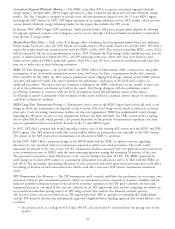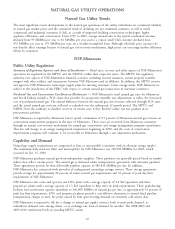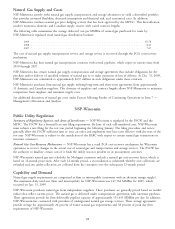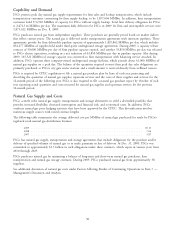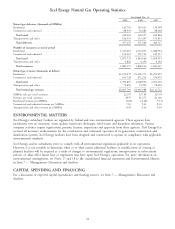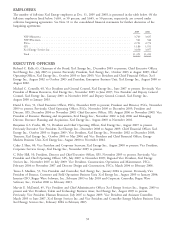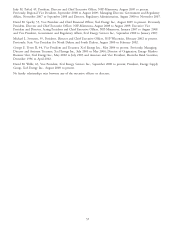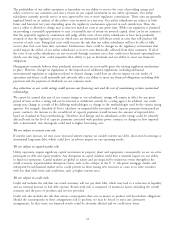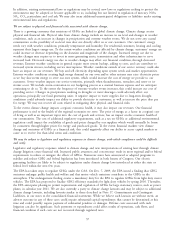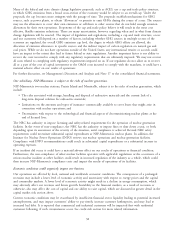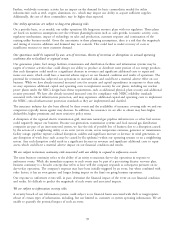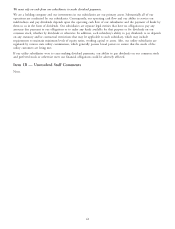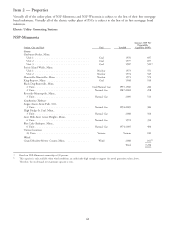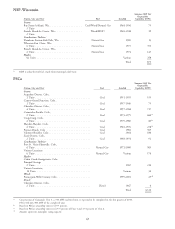Xcel Energy 2009 Annual Report Download - page 44
Download and view the complete annual report
Please find page 44 of the 2009 Xcel Energy annual report below. You can navigate through the pages in the report by either clicking on the pages listed below, or by using the keyword search tool below to find specific information within the annual report.Item 1A — Risk Factors
Oversight of Risk and Related Processes
The goal of Xcel Energy’s risk management process is to understand and manage material risk; management is
responsible for identifying and managing the risks, while directors oversee and hold management accountable. Our risk
management process has three parts: identification and analysis, management and mitigation, and communication and
disclosure. Xcel Energy management identifies and analyzes risks to determine materiality and other attributes like
timing, probability and controllability.
Management broadly considers our business, the utility industry, the domestic and global economy, and the
environment to identify risks. Identification and analysis occurs formally through a key risk assessment process
conducted by senior management, the securities disclosure process, the hazard risk management process, and internal
auditing and compliance with financial and operational controls. Management also identifies and analyzes risk through
its business planning process and development of goals and key performance indicators, which include risk
identification to determine barriers to implementing Xcel Energy’s strategy. At the same time, the business planning
process identifies areas where a business area may take inappropriate risk to meet goals.
The goal of the risk management process is to mitigate the risks inherent in the implementation of Xcel Energy’s
strategy. The process for risk management and mitigation includes our code of conduct and other compliance policies,
formal structures and groups, and overall business management. At a threshold level, Xcel Energy has developed a
robust compliance program and promotes a culture of compliance, which mitigates risk. In addition to the code of
conduct, Xcel Energy has a robust compliance program, including policies, training and reporting options.
Building on the culture of compliance, Xcel Energy manages and mitigates risks through formal structures and groups,
including management councils, risk committees, and the services of corporate areas such as internal audit, the
corporate controller and legal services. While Xcel Energy has developed a number of formal structures for risk
management, many material risks affect the business as a whole and are managed across business areas.
Xcel Energy confronts legislative and regulatory policy and compliance risks, including risks related to climate change
and emission of CO2 and risks for recovery of capital and operating costs; resource planning and other long-term
planning risks, including resource acquisition risks; financial risks, including credit, interest rate and capital market risks;
and macroeconomic risks, including risks related to economic conditions and changes in demand for Xcel Energy’s
products and services. Cross-cutting risks such as these are discussed and managed across business areas and coordinated
by Xcel Energy’s senior management.
Management provides information to the Board in presentations and communications over the course of the Board
calendar. Senior management presents an assessment of key risks to the Board annually. The presentation of the key
risks and the discussion provides the Board with information on the risks management believes are material, including
the earnings impact, timing, likelihood and controllability. Based on this presentation, the Board reviews risks at an
enterprise level and confirms risk management and mitigation are included in Xcel Energy’s strategy.
The guidelines on corporate governance and committee charters define the scope of review and inquiry for the Board
and committees. The standing committees also oversee risk management as part of their charters. Each committee has
responsibility for overseeing aspects of risk and Xcel Energy’s management and mitigation of the risk. The Board has
overall responsibility for risk oversight. As described above, the Board reviews the key risk assessment process presented
by senior management. This key risk assessment analyzes the most likely areas of future risk to Xcel Energy. The Board
also reviews the performance and annual goals of each business area. This review, when combined with the oversight of
specific risks by the committees, allows the Board to confirm risk is considered in the development of goals and that
risk has been adequately considered and mitigated in the execution of corporate strategy.
Risks Associated with Our Business
Our profitability depends in part on the ability of our utility subsidiaries to recover their costs from their customers and
there may be changes in circumstances or in the regulatory environment that impair the ability of our utility
subsidiaries to recover costs from their customers.
We are subject to comprehensive regulation by federal and state utility regulatory agencies. The utility commissions in
the states where we operate our utility subsidiaries regulate many aspects of our utility operations, including siting and
construction of facilities, customer service and the rates that we can charge customers. The FERC has jurisdiction,
among other things, over wholesale rates for electric transmission service, the sale of electric energy in interstate
commerce and certain natural gas transactions in interstate commerce.
34



